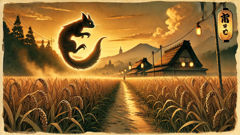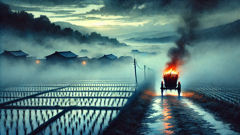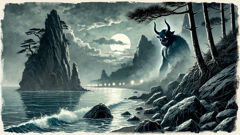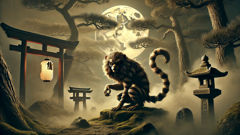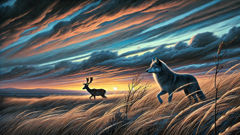Introduction
In the long valleys and windward ridges of rural Japan, where rice paddies quilt the lowlands and the ridgeline maps the movement of weather, an old explanation survives for the small, inexplicable cuts that sometimes appear on the skin of travelers: the kamaitachi. These are not merely hair-raising tales told to keep children close to hearthlight. The kamaitachi occupies a place between the observed and the imagined, a way for villagers to name a sudden bite of misfortune and to fold it into the order of the world. In the clearest versions of the story, a kamaitachi is a weasel yokai that rides on the edge of a dust devil or whirlwind, its claws honed like sickles. The wind lifts it across a path; the animal's blade whispers, and a traveler later discovers a shallow, bloodless wound as if cut by a razor that never touched the air they breathed. In other tellings, three kamaitachi work in sequence: the first knocks a person down, stunned; the second slices; the third applies a remedy that prevents the wound from worsening. Across regions, the narrative adapts: sometimes kamaitachi are vengeful spirits, sometimes mischievous nature-spirits, sometimes misunderstood animals whose presence warns of changing seasons. The story persisted because it does more than thrill. It teaches about the fragility of skin and pride, the speed of weather, and the humane rituals that communities developed—prayers, poultices, and sometimes rites of apology—when a cut could have been an offense against the living land. This account gathers those versions and sets them within the rhythms of medieval villages and the long gaze of landscapes that feel, even now, as if they might hide a small, razor-toothed creature in the turning dust.
Origins on the Wind: Myth, Farm, and Dust
In the earliest oral records and regional kyōka, kamaitachi lore answers for a real, sometimes repeated phenomenon: sudden light cuts that appear without the witness of a falling blade. To medieval farmers whose livelihoods depended on the body and skin of both humans and animals, naming such a thing mattered. If a worker returned from the winter field with a long, neat slice on the calf, or a child came home with a shallow gash that bled only a little, the pattern had to be explained. The story of the kamaitachi offered a plausible agent that fit the textures of rural life—small animals, wind, and the surprising ways both conspired against the sedentary human life. Folklorists who later gathered these tales found them shaped by landscape. In windy provinces like Echigo and Shinano, the kamaitachi was given more agency, often described as a pair or trio that worked with precise choreography; in wetter, sheltered basins, the yokai might be softer, more mischievous, or tied to other spirits such as tengu or foxes.
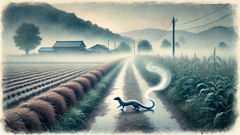
Those who lived through winters of powdered wind described how dust devils could form on well-trodden paths where loose earth dried to powder. A careless slip, a quick draft, the brush of rough clothing against a sharpened stone—any of those might create a slit. Yet the tale of a weasel riding the whirl and using its forepaws like blades both dignified and domesticated the event. The animal itself was familiar: weasels were common near granaries and thatched roofs; they ate rodents and snakes and were sometimes kept away with brooms. Turning such a known creature into a yokai made the occurrence less arbitrary. Instead of random, it became a story of intention, even if that intention remained inscrutable. Communities would attach meaning: an unpunished kamaitachi might signal neglect of a boundary shrine, a neglected field, or a household that had not fed its small gods.
The three-kamaitachi motif is especially striking to scholars because it encodes a full cycle—harm and healing—within the same act. One of the weasels strikes to stagger a passerby; the second slices; the third heals. In later retellings this sequence becomes moralized: perhaps the third is a benevolent spirit who corrects the first two's mischief, or perhaps it is a healer yokai that receives offerings. The idea of sequence also points to communal responses. When a cut was discovered, villagers did not panic; they performed checks, asking neighbors about wind patterns or whether the path had been swept. A wound without a pattern might be wrapped in rice bran, an application that both staunched and symbolically returned the injury to the earth. Healers—village midwives, bone-setters, and itinerant medicine peddlers—created remedies whose recipes read now like ethnographic windows: mullein poultices to cool, ash and rice bran to bind, prayers to the local jinja to ensure the wind spirits would not return. Thus the kamaitachi, though small, helpfully organized responses to risk: naming led to treating, and treating led to ritualized attention to limits between house, field, and the open world.
Beyond healing, the kamaitachi served as a diagram for social anxieties. Towns kept lists of wrongs: unpaid debts, broken promises, straw roofs left unthreshed. To attribute a cut to a yokai meant one could also interpret it: perhaps a kamaitachi's strike was a reminder that the roadside shrine had not been honored, that the granary door had been left ajar, or that a newlywed had offended a household god. The boundary between practical advice and supernatural admonition is thin in these tales. Elders would caution children to avoid the windy crest where the small whirlforms gather; couples were urged to keep small offerings at thresholds during breezy months. Markets thrummed with talk of places where one might meet a kamaitachi at dawn—thumbs pointed at particular fields or rutted lanes—and travelers learned to avoid them when carrying fragile wares. These practices turned an uncertain hazard into communal wisdom: leave an offering, sweep the path, mend the fence, and the kamaitachi will pass without interest.
In literature, monks and itinerant storytellers used the kamaitachi to teach about attention. One tale tells of a shoemaker who ignored a stray kitten and later fell ill after a series of small, unexplained wounds; only a vow to feed the cats and sweep the shrine restored his health. Another story reverses the moral: a prosperous farmer who refused to share grain with a passing mendicant was struck repeatedly throughout a week by invisible slashes until he confessed and made amends. Versions differ, but the narrative utility remains: the kamaitachi is a force that ties human action to consequence, and the wind that carries its claws is indifferent to rank. Such stories functioned as social glue—gentle coercion that encouraged reciprocity and careful stewardship of the natural and built environment.
Scholars of folklore have also traced how kamaitachi beliefs changed with time. In the Edo period, as roads improved and information traveled, the yokai migrated into printed collections and ukiyo-e woodcuts. Artists favored dramatic single-frame moments: a weasel's eyes caught in mid-glow, a ribbon of wind curving around a startled traveler, a scar that was both real and artful. The image stabilized and the story spread. With the modernization of the Meiji era, the kamaitachi shifted again—sometimes retained as quaint rural superstition, sometimes reinterpreted by writers as psychological metaphor for sudden pain or guilt. Yet in villages, the old rituals endured. When a child woke with a shallow cut and no memory of it, the family took care: cooled the skin, bound it with clean cloth, offered a small bowl of rice at the roadside protector's stone. The act of tending became itself a spell against future shocks.
And so the kamaitachi remained, a brief interruption in ordinary days—a sting teaching attentiveness. The weasel yokai's presence taught people to watch the weather, to walk the line between hedgerow and field, to keep thresholds tidy. In an agrarian economy where every bruise or bite could have consequences, such small attentions were practical ritual. To teach a child not to run a sudden gale's crest was the same as teaching them to patch a net or mend a boot. The legend of the kamaitachi shows how environment, plausible physical forces, and cultural imagination combine to create durable, useful beliefs that both explain and order daily life.
The Cut, the Cure, and the Quiet Justice
Stories about kamaitachi wounds are as practical as they are eerie. Many retellings emphasize the small rituals that communities developed: a wound might be cleaned with cold water, rubbed with ash to staunch any bleeding, and then gently massaged with a poultice made from rice bran and plantain leaves. These are not fanciful recipes but measures grounded in empirical observation. Rice bran acts as a dessicant and antiseptic by traditional knowledge, while plantain and certain mosses possess soothing properties. A healer's skill did not always lie in supernatural power but in experience, and experience learned from generations of tending scraped hands and split bellies. When a wound was thought to be the kamaitachi's, the remedy frequently included abandoning the idea of punishment. Instead, villagers sought reconciliation. The idea of offering a bit of rice at a roadside or a cup of sake at a hidden stone wasn't merely superstition; it created a practice of attention and reciprocity that bound communities to their surroundings. Who would want to offend the invisible creatures that made life sharp and unpredictable?
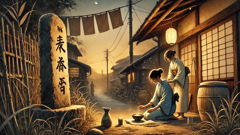
The ethical dimensions embedded in kamaitachi tales can be startlingly direct. In one version, a young woodcutter refuses to carry water to an old woman living by the path. He is later found gashed and faint, and the villagers say with a mixture of sorrow and moral clarity that the wind itself learned of his neglect. The narrative ends not with vengeance but with restitution: the woodcutter apologizes and returns to serve the woman, and the cuts stop appearing. In another tale, a woman of great pride refused to repair her nets after a storm, and each morning she discovered a new shallow cut on her hands; only when she mended the nets and shared fish with neighbors did the phenomenon cease. These stories teach that the kamaitachi enforces, gently and persistently, the social fabric of mutual care that rural life requires. This gives the yokai a role beyond haunting: it becomes an agent of social memory.
From a symbolic angle, the kamaitachi's blade-like claws can be read as an allegory for the invisible consequences of neglect. A single overlooked obligation does not always produce immediate ruin; instead, it yields small incursions—cuts that sting and then heal, reminders that demand attention before damage deepens. The third kamaitachi who heals can be interpreted as the community itself: attentive neighbors, wise women, and local priests who close wounds and restore equilibrium. In this sense, the mythology dramatizes processes that any small community performs—monitoring the body, tending the land, exchanging favors. It is telling that the story rarely glorifies solitary toughness. Courage in these tales is practical: tending the sick, returning what was taken, acknowledging failings. That humility is the cure.
The interplay of fear and consolation in kamaitachi lore found fresh life in urbanizing Japan, where the yokai was sometimes invoked as an exotic tradition of the provinces. Writers of the Meiji and Taishō periods used it to reflect on the loss of older networks. As people moved to cities, the rituals of offering at roadside stones and the communal tending of wounds faded for many. In their place, the kamaitachi persisted in memory and art, a figure who sliced illusions of invulnerability. Later, 20th-century authors and directors would use the weasel yokai to explore modern anxieties about anonymity, the sudden incursions of pain in modern life, and the quiet moral tests that urban communities still perform in different forms.
For anyone walking a rural ridge today, the kamaitachi remains a useful image. Modern hikers find small cuts and wonder whether the explanation is brambles, barbed grasses, or human carelessness; the old yokai gives them a story that prompts practical action. Where once elders would leave a saucer of rice, now a group might clean a path or repair a fence. The legend still encourages precaution and kindness. It is a repository of common-sense remedies: clean a wound promptly, bind it, and in doing so, attend to small duties that preserve communal life. The persistence of the legend also shows how regional beliefs adapt. In some tourist literature, kamaitachi are now stylized as cute, quick weasels: merchandised figures that soften what were once sharp warnings. In other places, local festivals keep the older edge—recreating gusty demonstrations, dolls with tiny scythe-like claws, and dramatic retellings that emphasize the yokai's dual nature as nuisance and guardian.
Beyond the local, the kamaitachi offers a lesson in how people integrate observation into story. Wind and animal, cut and cure, social reprimand and neighborly care: these elements form a compact model of how belief functions in a pre-modern landscape. The yokai is neither wholly malignant nor benign; it is an exemplar of ecological intelligence, a shorthand for those fine-grained attentions that a human life claims when it lives by the weather. So the next time you find a small slice on your skin, think of the kamaitachi not only as a fable but as a prompt: check the edge of the path, patch the torn net, sweep the shrine, and make an offering. Those acts are the cultural knowledge encoded in a sharp, whispering myth.
Conclusion
The kamaitachi remains more than a ghost story; it is a cultural tool for making sense of sudden harm and the weather's unpredictability. In the interplay of animal, wind, and social response, the legend teaches attentiveness, reciprocity, and a practical ethic toward the land and neighbors. Whether invoked in old shrines or modern novels, the weasel yokai reminds us that small wounds ask for small rituals and that those rituals sustain a community’s capacity to care. Keep a watchful eye on the ridge, repair what is torn, and offer what is due—these are the enduring cures the kamaitachi’s story asks of us.

